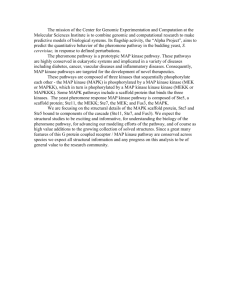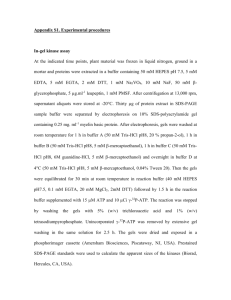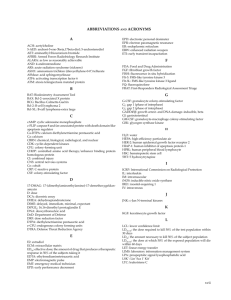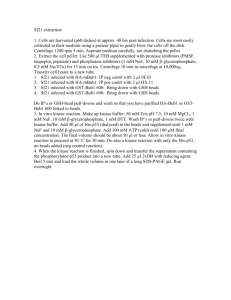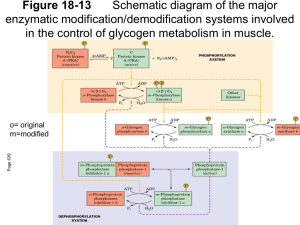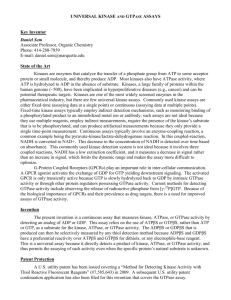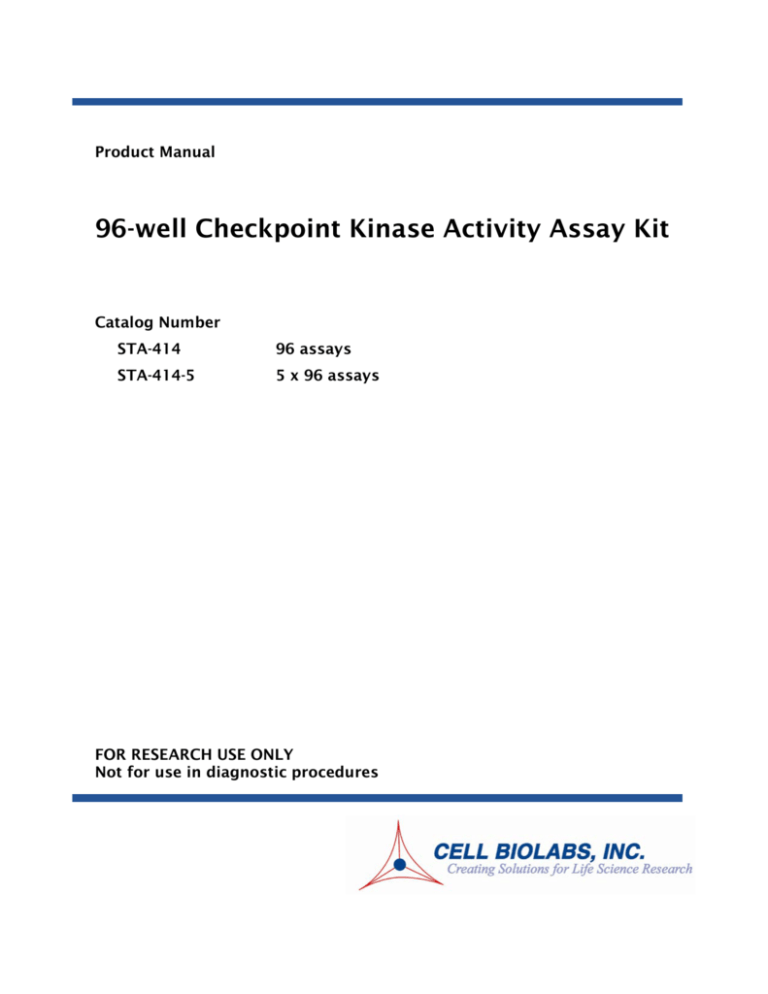
Product Manual
96-well Checkpoint Kinase Activity Assay Kit
Catalog Number
STA-414
96 assays
STA-414-5
5 x 96 assays
FOR RESEARCH USE ONLY
Not for use in diagnostic procedures
Introduction
Cdc25C is a protein phosphatase responsible for dephosphorylating and activating Cdc2, a critical step
in regulating mitosis in eukaryotic cells. Cdc25C is constitutively phosphorylated at Ser216 throughout
interphase by c-TAK1 (Cdc25C associated protein kinase), while phosphorylation at this site is DNA
damage dependent at the G2/M checkpoint. Prior to mitosis, checkpoint kinases (CHK1 and CHK2)
can be activated in response to DNA damage, phosphorylating Cdc25C at Ser216, ultimately leading to
cell cycle arrest. Consequently, a cell is prevented from entering mitosis and passing this damage to
daughter cells. Mutations to these checkpoint kinases lead to decreased DNA repair and increased
susceptibility to cancer.
Cell Biolabs’ 96-well Checkpoint Kinase Activity Assay Kit is an enzyme immunoassay developed for
detection of the specific phosphorylation of Cdc25C at Ser216 by Checkpoint Kinases (CHK1 and
CHK2). First, the substrate is incubated with checkpoint kinase sample in solution (such as purified
kinase, cell or tissue lysate). After the kinase reaction, the solution is transferred to a Kinase Substrate
Capture Plate, where the phosphorylated Cdc25C is finally detected by an Anti-Phospho-Cdc25C
(Ser216) Antibody (see Assay Principle).
Cell Biolabs’ 96-well Checkpoint Kinase Activity Assay Kit provides a non-isotopic, sensitive and
specific method to monitor checkpoint kinase activity using its physiological substrate; it can also be
used in screening checkpoint kinase inhibitors. The kit has detection sensitivity limit of ~300 pg of
active CHK1. A recombinant active CHK1 is also provided as a positive control. Each kit provides
sufficient quantities to perform up to 96 assays.
Related Products
1. STA-320: OxiSelect™ Oxidative DNA Damage ELISA Kit (8-OHdG Quantitation)
2. STA-321: OxiSelect™ DNA Double-Strand Break (DSB) Staining Kit
3. STA-322: OxiSelect™ UV-induced DNA Damage ELISA Kit (CPD Quantitation)
4. STA-323: OxiSelect™ UV-induced DNA Damage ELISA Kit (6-4PP Quantitation)
5. STA-324: OxiSelect™ Oxidative DNA Damage Quantitation Kit (AP sites)
6. STA-326: OxiSelect™ Cellular UV-induced DNA Damage ELISA Kit (CPD)
7. STA-327: OxiSelect™ Cellular UV-induced DNA Damage Staining Kit (CPD)
8. STA-328: OxiSelect™ Cellular UV-induced DNA Damage ELISA Kit (6-4PP)
9. STA-329: OxiSelect™ Cellular UV-induced DNA Damage Staining Kit (6-4PP)
10. STA-413: Checkpoint Kinase Activity Immunoblot Kit
11. STA-415: ROCK Activity Immunoblot Kit
12. STA-416: 96-well ROCK Activity Assay Kit
2
Assay Principle
3
Kit Components
Box 1 (shipped at room temperature)
1. Checkpoint Kinase Substrate Capture Plate (Part No 241401): One strip well 96-well plate.
2. 10X Checkpoint Kinase Substrate (Part No 241402): One vial – 1.5 mL containing
recombinant Cdc25C.
3. 10X Kinase Buffer (Part No. 241602): One bottle – 20 mL of 250 mM Tris, pH 7.5, 100 mM
MgCl2, 50 mM Glycerol-2-Phosphate, 1 mM Na3VO4.
4. ATP Solution (Part No. 241604): One vial – 100 μL of 100 mM ATP.
5. Anti-Phospho-Cdc25C (Ser216) Antibody (Part No. 241403): One vial – 20 μL.
6. Secondary Antibody, HRP Conjugate (Part No. 10902): One vial – 20 μL.
7. Assay Diluent (Part No. 310804): One 50 mL bottle.
8. 10X Wash Buffer (Part No. 310806): One 100 mL bottle.
9. Substrate Solution (Part No. 310807): One 12 mL amber bottle.
10. Stop Solution (Part. No. 310808): One 12 mL bottle.
Box 2 (shipped on blue ice packs)
1. Active CHK1 (Part No. 241303): One vial – 20 μL containing 50 ng active CHK1 in 25 mM
Tris, pH 7.5, 10 mM MgCl2, 5 mM Glycerol-2-Phosphate, 0.1 mM Na3VO4, 10% Glycerol,
0.1% BSA.
Materials Not Supplied
1. Checkpoint kinase sample (purified kinase, cell or tissue lysate)
2. Lysis Buffer: 50 mM Tris-HCl, pH 7.5, 150 mM NaCl, 1 mM 2-glycerophosphate, 1 % Triton
X-100 or 1 % Nonidet P-40, 1 mM EDTA, 1 mM EGTA, 1 mM Na3VO4 and Proteinase
inhibitors.
3. 1M DTT
4. 30°C incubator or water bath
5. 10 µL to 1000 µL adjustable single channel micropipettes with disposable tips
6. 50 µL to 300 µL adjustable multichannel micropipette with disposable tips
7. Multichannel micropipette reservoir\
8. Microplate reader capable of reading at 450 nm (620 nm as optional reference wave length)
Storage
Store active CHK1 at -80ºC, ATP Solution at -20ºC and all other kit components at 4ºC until their
expiration dates. Avoid multiple freeze/thaw cycles.
4
Preparation of Reagents
•
•
•
•
1X Kinase Buffer: Dilute the 10X Kinase Buffer Concentrate to 1X with deionized water. Stir
to homogeneity.
Note: Do not dilute the entire bottle of 10X Kinase Buffer. The kinase reaction requires 10X
Kinase Buffer concentrate. Prepare only the minimum volume of 1X for the experiment.
10X Kinase Reaction Buffer/DTT/ATP: Just prior to usage, add DTT to a final concentration of
10 mM and ATP to a final concentration of 2 mM to the 10X Kinase Buffer. For Example, add
10 μL of 1M DTT (not provided) and 20 μL of 100 mM ATP solution to 970 uL of 10X Kinase
Buffer. 10X Kinase Reaction Buffer containing DTT and ATP may be stored at 4°C for short
term (1-2 weeks).
1X Wash Buffer: Dilute the 10X Wash Buffer Concentrate to 1X with deionized water. Stir to
homogeneity.
Anti-Phospho-Cdc25C (Ser216) Antibody and HRP-Conjugated Secondary Antibody:
Immediately before use dilute the Anti-Phospho-Cdc25C (Ser216) Antibody 1:1000 and HRPConjugated Secondary Antibody 1:1000 with Assay Diluent. Do not store diluted solutions.
Assay Protocol
I. Kinase Reaction (samples should be assayed in duplicate)
1a. For immunoprecipitations with anti-checkpoint kinase antibody: Kinase is first
immunoprecipitated from cell or tissue lysate with an anti-checkpoint kinase antibody and
Protein A/G bead slurry. Immediately before the kinase assay, wash the bead slurry once with
1X Kinase Buffer. Remove all supernatant and add 120 μL of 1X Kinase Buffer. Next, add 15
μL of 10X Kinase Reaction Buffer/DTT/ATP, mixing well (see Preparation of Reagents
Section). Initiate the kinase reaction by adding 15 μL of 10X Checkpoint Kinase Substrate.
1b. Purified Kinase or Cell Lysate: Purified kinase or cell lysate sample can be used directly in the
kinase assay or further diluted with 1X Kinase Buffer. Add 120 μL of checkpoint kinase
sample to a microcentrifuge tube or microtiter plate. Next, add 15 μL of 10X Kinase Reaction
Buffer/DTT/ATP, mixing well (see Preparation of Reagents Section). Initiate the kinase
reaction by adding 15 μL of 10X Checkpoint Kinase Substrate.
2. (optional) Add 4 μL of the provided active CHK1 and 116 μL of 1X Kinase Buffer to a
microcentrifuge tube or microtiter plate. Next, add 15 μL of 10X Kinase Reaction
Buffer/DTT/ATP, mixing well (see Preparation of Reagents Section). Initiate the kinase
reaction by adding 15 μL of 10X Checkpoint Kinase Substrate.
3. Incubate the tubes or plate at 30°C for 1-2 hours with gentle agitation.
4. For immunoprecipitated samples (step 1a), centrifuge tubes for 10 seconds at 12,000 x g.
II. Transfer and Detection
1. Transfer 100 µL of kinase reaction sample to a well of the Checkpoint Kinase Substrate
Capture Plate.
2. Cover with a plate cover and incubate at room temperature for 1 hour on an orbital shaker.
5
3. Remove plate cover and empty wells. Wash microwell strips once with 250 µL 1X Wash
Buffer. Empty the wells and tap microwell strips on absorbent pad or paper towel to remove
excess 1X Wash Buffer.
4. Add 200 µL of Assay Diluent to each well. Cover with a plate cover and incubate at room
temperature for 30 minutes on an orbital shaker.
5. Remove plate cover and empty wells. Wash microwell strips 5 times with 250 µL 1X Wash
Buffer per well with thorough aspiration between each wash. After the last wash, empty wells
and tap microwell strips on absorbent pad or paper towel to remove excess 1X Wash Buffer.
6. Add 100 µL of the diluted Anti-Phospho-Cdc25C (Ser216) Antibody to each well.
7. Cover with a plate cover and incubate at room temperature for 1 hour on an orbital shaker.
8. Remove plate cover and empty wells. Wash the strip wells 5 times according to step 5 above.
9. Add 100 µL of the diluted Anti-Phospho-Cdc25C (Ser216) Antibody to each well.
10. Cover with a plate cover and incubate at room temperature for 1 hour on an orbital shaker.
11. Remove plate cover and empty wells. Wash the strip wells 5 times according to step 5 above.
12. Add 100 µL of the diluted HRP-Conjugated Secondary Antibody to each well.
13. Cover with a plate cover and incubate at room temperature for 1 hour on an orbital shaker.
14. Remove plate cover and empty wells. Wash microwell strips 5 times according to step 5 above.
Proceed immediately to the next step.
15. Warm Substrate Solution to room temperature. Add 100 µL of Substrate Solution to each well,
including the blank wells. Incubate at room temperature for 5-20 minutes on an orbital shaker.
16. Stop the enzyme reaction by adding 100 µL of Stop Solution into each well, including the
blank wells. Results should be read immediately (color will fade over time).
17. Read absorbance of each microwell on a spectrophotometer using 450 nm as the primary wave
length.
6
Example of Results
The following figure demonstrates typical results seen with Cell Biolabs’ 96-well Checkpoint Kinase
Activity Assay Kit. One should use the data below for reference only.
3
OD 450nm
2.5
2
1.5
1
0.5
0
0
5
10
15
20
25
CHK1 Kinase (ng/well)
Figure 1: CHK1 Kinase Activity Assay. Active CHK1 was incubated for 2 hours at 30°C as
described in the Assay Protocol.
Figure 2: CHK1 Activity Immunoblot Assay. 25 μL of 1X Kinase Buffer containing 10 ng of active
CHK1 was incubated with 50 μL of 1X Kinase Buffer containing 0.2 mM ATP and 8 μg of
recombinant Cdc25C for 60 minutes at 30°C. Kinase reaction was stopped by adding 25 μL of 4X
SDS-PAGE Sample Buffer. Lane 1: Without kinase (negative control); Lane 2: with kinase.
Phosphorylation of Cdc25C substrate was detected by anti-phospho-Cdc25C (Ser216) antibody as
described in Assay Protocol for Cat. #STA-413.
7
References
1.
2.
3.
4.
Zhou, B. B., and Elledge, S. J. (2000) Nature 408, 433-439
Matsuoka, S., Huang, M., and Elledge, S. J. (1998) Science 282, 1893-1897
Ahn, J., Urist, M., and Prives, C. (2004) DNA Repair 3, 1039-1047
Ahn, J., and Prives, C. (2002) J. Biol. Chem. 277, 48418-48426
Warranty
These products are warranted to perform as described in their labeling and in Cell Biolabs literature when used in
accordance with their instructions. THERE ARE NO WARRANTIES THAT EXTEND BEYOND THIS EXPRESSED
WARRANTY AND CELL BIOLABS DISCLAIMS ANY IMPLIED WARRANTY OF MERCHANTABILITY OR
WARRANTY OF FITNESS FOR PARTICULAR PURPOSE. CELL BIOLABS’ sole obligation and purchaser’s
exclusive remedy for breach of this warranty shall be, at the option of CELL BIOLABS, to repair or replace the products.
In no event shall CELL BIOLABS be liable for any proximate, incidental or consequential damages in connection with the
products.
Contact Information
Cell Biolabs, Inc.
7758 Arjons Drive
San Diego, CA 92126
Worldwide: +1 858-271-6500
USA Toll-Free: 1-888-CBL-0505
E-mail: tech@cellbiolabs.com
www.cellbiolabs.com
2011: Cell Biolabs, Inc. - All rights reserved. No part of these works may be reproduced in any form without permissions
in writing.
8



